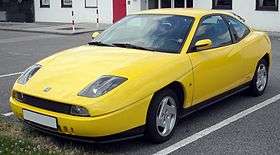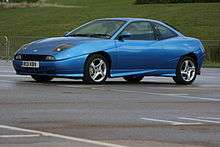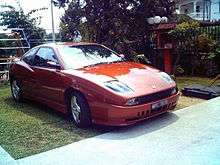Fiat Coupé
The Fiat Coupé, internally designated as the type 175, was a two door, four seat coupé manufactured and marketed by Fiat between 1993 and 2000 across a single generation. The Coupé was introduced at Bologna Motor Show in December 1993 and is noted for its distinctive, angular exterior design by Chris Bangle at Centro Stile Fiat. Its interior was designed by Pininfarina.
| Fiat Coupé | |
|---|---|
 | |
| Overview | |
| Manufacturer | Fiat |
| Production | 1993–2000 |
| Assembly | Turin, Italy (Pininfarina)[1] |
| Designer | Chris Bangle, at Centro Stile Fiat (1991) Pininfarina (Interiors) |
| Body and chassis | |
| Class | Sports car (S) |
| Body style | 2-door coupé |
| Layout | FF layout |
| Platform | Type Two |
| Powertrain | |
| Engine | 1.8 l4 16V 2.0 l4 16V 2.0 Fiat family C l5 20V 2.0 Fiat Twin Cam engine l4 16V Turbo 2.0 Fiat Family C l5 20V Turbo |
| Transmission | 5 and 6-speed manual |
| Dimensions | |
| Wheelbase | 2,540 mm (100.0 in) |
| Length | 4,250 mm (167.3 in) |
| Width | 1,768 mm (69.6 in) |
| Height | 1,340 mm (52.8 in) |
| Curb weight | 1,250–1,320 kg (2,760–2,910 lb) |
History

The Fiat Coupé made media headlines in auto magazines during 1992, after several spy shots were taken revealing the car on test. Fiat had decided to produce a new coupé based upon the Tipo platform when the Pininfarina factory was suddenly dormant after the Cadillac Allante project failed around 1990.[2] Two designs were put forward, with Fiat's in-house Centro Stile team competing with Pininfarina.The concept as put forward by Centro Stile's Chris Bangle unexpectedly won the Fiat management over. The design previously offered by Pininfarina was eventually accepted by Peugeot, who adopted it as the 406 Coupe in October 1996.
On its launch in January 1994, the Coupé was available with a four cylinder, 2.0 L 16V engine, in both turbo (190 PS) and normally aspirated (139 PS) versions. Both engines were later versions of Fiat's twin-cam design and inherited from the Lancia Delta Integrale, winner of the World Rally Championship a record six times. 1996 brought in a 1.8 L 16V engine (not available in the United Kingdom, 131 PS), along with a 2.0 litre five cylinder 20V (147 PS), and a five cylinder 2.0 litre 20V turbo (220 PS). Along with the new engines Fiat also made some minor design changes including the front grill, steering wheel ,the door panel now included leather, the interior centre console was redesigned and the digital clock was replaced with an analog one.
Production of the right-hand drive models for markets including the UK began in early 1995, and continued until the end of Coupe production five years later.

Both the turbocharged 16v/4-cylinder and 20v/5-cylinder (4v per cyl.) versions were equipped with a very efficient Viscodrive limited-slip differential to counter the understeer that plagues most powerful front wheel drive cars.
Additionally, the Coupé featured independent suspension all round: at the front MacPherson struts and lower wishbones anchored to an auxiliary crossbeam, offset coil springs and anti roll bar; at the rear, trailing arms mounted on an auxiliary subframe, coil springs and an anti roll bar.
| Year | Units made |
|---|---|
| 1993 | 119 |
| 1994 | 17,619 |
| 1995 | 13,732 |
| 1996 | 11,273 |
| 1997 | 12,288 |
| 1998 | 9,042 |
| 1999 | 6,332 |
| 2000 | 2,357 |
| Total | 72,762 |
.jpg)
1998 saw the release of the Limited Edition which could be identified externally by a body kit, titanium grey details such as the wheels, fuel cap, rear light cups, mirror casings and the Brembo brake calipers at the front were now painted red. Inside, the Limited Edition specification included a push-button start, Recaro seats with red leather inserts, Sparco pedals and the recognisable body-coloured dash was replaced with a titanium grey example. Mechanically, there were few changes over a standard 20V Turbo model, but the LE (as they came to be known) did add a six speed gearbox for the first time, strut brace and the engine covers were all painted red.[3]
The LE was produced in Black (flat), Red (flat), Vinci Grey (metallic), Crono Grey (flat) and Steel Grey (metallic).
Each Limited Edition ('LE') Coupé was manufactured with a badge located by the rear view mirror which contained that car's unique number (it is rumoured that Michael Schumacher was the original owner of LE No. 0001, however when the question was raised to him personally he confirmed he had owned one, but a red one, while LE No. 0001 is a Crono Grey one). Originally, a spokesman from Fiat stated only approximately 300 Limited Editions would be built (although the plaques always allowed for four-figure numbers). The final amount was much higher, with numbers as high as 1400 touted by some. This angered many of the owners of the original 300 cars and almost certainly impacted residual values. The original number however was quoted by a spokesman for Fiat UK, so probably that number only applied to the United Kingdom.

In 1998, the 2.0 litre five cylinder 20V got a Variable Inlet System, which brought the power to 154 PS (113 kW). In addition, the sills of the Turbo version were colour matched with the body paintwork. Fiat also released the 2.0 litre five cylinder Turbo 'Plus'. This model came with an option kit that made it virtually identical to the LE, except for minor interior design changes and without the unique identification badge of the LE.
In early 2000, Fiat released another special version of the Fiat Coupé. Featuring the 1.8 litre engine, it was only available throughout mainland Europe and marketed as an elegant and affordable edition. This final version had different leather seats, white speedo with yellow arrows, new 16 inch bbs rims and the new "honeycomb"grill. Production finished in the summer of that year, with no plans for a direct successor.
Fiat also made changes throughout the rest of the range: new seats, side skirts, wheels for the 2.0 litre 20V model, 'Plus' edition wheels and a six speed transmission as standard on turbo models, and Fiat manufactured seats on the 'Plus' that were virtually identical to the original Plus Recaro seats with the addition of extra airbags.
The 2.0 litre 20V Turbo model is capable of accelerating from 0–100 km/h (0 to 62 mph) in 6.5 seconds and 6.3 seconds for the 20v Turbo Plus, with a top speed of 240 km/h (149 mph) or 250 km/h (155 mph) with later six speed gearbox. When production finally ended in December 2000, a total number of 72,762 units had been produced.


Engines
| Model[4][5] | Engine | Displacement | Power | Torque | 0–100 km/h (0-62 mph) | Top speed |
|---|---|---|---|---|---|---|
| 1.8 16V | I4 | 1747 cc | 131 PS (96 kW; 129 hp) @6300 rpm | 164 N⋅m (121 lb⋅ft) @4300 rpm | 9.2 s | 205 km/h (127 mph) |
| 2.0 16V | I4 | 1995 cc | 139 PS (102 kW; 137 hp) @6000 rpm | 180 N⋅m (133 lb⋅ft) @4500 rpm | 9.2 s | 208 km/h (129 mph) |
| 2.0 20V | I5 | 1998 cc | 147 PS (108 kW; 145 hp) @6100 rpm | 186 N⋅m (137 lb⋅ft) @4500 rpm | 8.9 s | 212 km/h (132 mph) |
| 2.0 20V V.I.S. | I5 | 1998 cc | 154 PS (113 kW; 152 hp) @6700 rpm | 186 N⋅m (137 lb⋅ft) @3750 rpm | 8.4 s | 217 km/h (135 mph) |
| 2.0 16V Turbo | I4 | 1995 cc | 190 PS (140 kW; 187 hp) @5500 rpm | 290 N⋅m (214 lb⋅ft) @3400 rpm | 7.5 s | 225 km/h (140 mph) |
| 2.0 20V Turbo | I5 | 1998 cc | 220 PS (162 kW; 217 hp) @5750 rpm | 310 N⋅m (229 lb⋅ft) @2500 rpm | 6.3 s | 240 km/h (149 mph)(5-speed) 250 km/h (155 mph)(6-speed) |
Tuning, modifying and racing
Since the turbo versions shared their motors with a few popular Fiats and Lancia's they are a known base to a lot of European tuners.
The 16v/20v turbo engines are sought after because of their huge tuning headroom and simple design which makes them easy to swap in other Fiat/Lancia/Alfa Romeo cars.
The most common swap chassis are Fiat Bravo HGT and Alfa Romeo GTV since they share a very similar platform.
4wd conversions have been done quite a few times to the Coupe chassis since it shares a similar floor pan as the Alfa Romeo 155 Q4 and Lancia Delta/Dedra Integrale
References
- "PRODUZIONE COMPLESSIVA" (PDF). pininfarina.it. Archived from the original (PDF) on 5 June 2011. Retrieved 3 August 2007.
- "Chris Bangle On The Design Of The Fiat Coupe".
- "Fiat Coupé Buyer's Guide - italicar".
- "Coupé Fiat Technical Specifications". fiatcoupehistory.com. Archived from the original on 29 September 2007. Retrieved 6 August 2007.
- "The Fiat Coupe". fiatcoupe.cqnet.com.au. Archived from the original on 29 August 2007. Retrieved 6 August 2007.
External links
| Wikimedia Commons has media related to Fiat Coupé. |
- Modified Fiat Coupe 20v Turbo
- Fiat Coupé Club UK
- Club Fiat Coupé Passion ITA
- Club Fiat Coupé España ESP